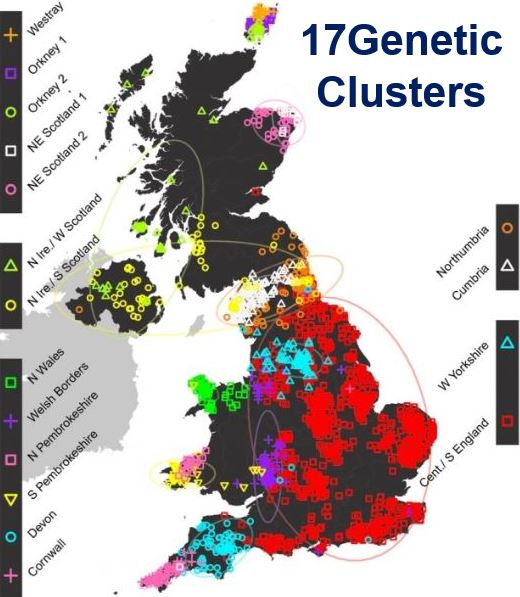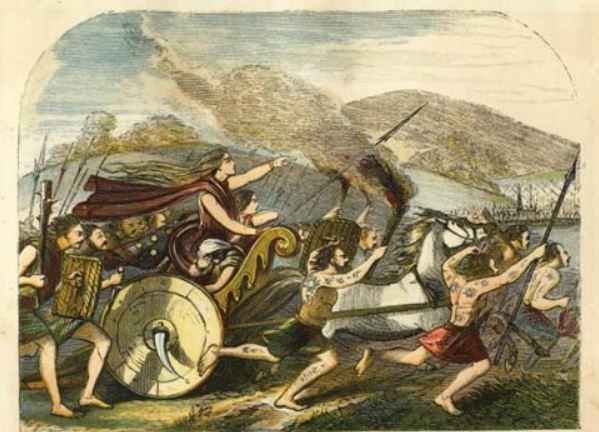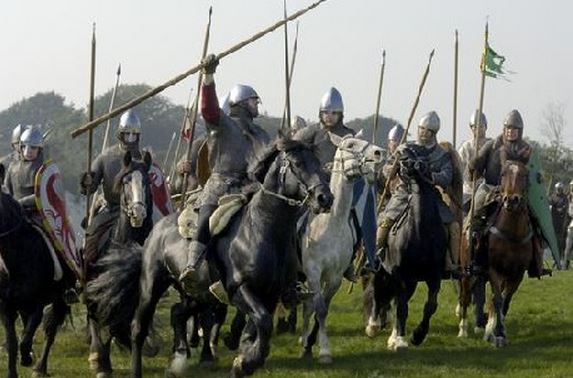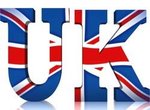While Britons share about 30% of their DNA with modern Germans, through the Anglo-Saxons who came to the islands around 1500 years ago, there is very little genetic trace today of Normans, Vikings or Romans, a new study has revealed.
The study, carried out by an international team of scientists, showed that the Anglo-Saxons – people from Germanic tribes who migrated from continental Europe – were the only conquering force, about 400-500 AD, to considerably contribute to modern Britons’ genetic makeup.
Most modern white Britons’ DNA appears to have come from people migrating after the last Ice Age and before the Romans came.

Map of the 17 regional clusters revealed by genetic analysis. (Image: WTCHG)
In this first comprehensive analysis of the UK population, subtle variations in the genetic makeup of modern Britons reflect the islands’ history through the colonization of people’s from continental Europe since the last Ice Age.
Peter Donnelly, Director of the Wellcome Trust Centre for Human Genetics (WTCHG), who co-directed the study with Simon Myers, also from WTCHG, Stephen Leslie of Murdoch Childrens Research Institute in Australia, and Garrett Hellenthal from University College London, said:
“It has long been known that human populations differ genetically, but never before have we been able to observe such exquisite and fascinating detail.”
Invaders mixed with local populations
The researchers, who published their findings in the academic journal Nature (citation below), confirm that the invaders of the British Isles never wiped out existing populations but interbred with them.
The genetic analysis shows significant traces throughout the United Kingdom of DNA which came from the earliest setters of Britain after the last Ice Age.
The highest proportion of this early British DNA was found among the people of Wales. However, even in eastern central and southern regions, which were settled by Anglo-Saxons after the Roman Empire fell, the DNA of Anglo-Saxon origins makes up no more than 40% of people’s genetic inheritance.
The project was the brainchild of Sir Walter Bogmer, from the Department of Oncology at WTCHG. He wanted to determine whether there were meaningful levels of genetic differentiation between UK populations as a background to studies of genetic diseases.

Queen Boadicea leading the Britons against the Romans. The study found there is no single Celtic group.
Sir Walter and colleagues gathered DNA samples of 2,039 Britons in rural areas. All their four grandparents had been born within a 50 mile (80 km) radius of each other. Effectively, this made it possible to sample the grandparents’ DNA, all of whom had been born before the major population movements of the twentieth century.
The scientists used statistical tools to compare participants’ DNA at an unprecedented level of detail.
Genetic clusters coincided with geographical areas
Their analysis found that the samples could be grouped into 17 different clusters, which coincided closely with geographical areas. For example, people in Orkney were very different from all the other groups, while those in Cornwall differed from their neighbours in Devon.
The research team then compared each cluster’s DNA with samples from 6,209 people in ten nations in Europe with a history of migration to Britain.
They found that Orkney’s unique signature was the result of a strong dose of Norse Viking DNA, while the Danish dominance in eastern and northern England from the 9th to 11th centuries left virtually no genetic trace at all.

Surprisingly, there is very little trace of Norman genes in modern Britons’ DNA. (Image: English Heritage)
The study was reliant on high-performance computing and sophisticated statistical techniques, recently developed by Garrett Hellenthal, Simon Myers and two more colleagues, to uncover these subtle effects.
Myers said:
“In future, increasingly large datasets will allow us to learn even more about the genetic history of the UK, and the similarly rich histories of other world regions, by applying similar techniques.”
There is no single ‘Celtic’ genetic group
The team found that in the Celtic parts of the UK – Cornwall, Wales, Northern Ireland and Scotland – genetically they are the most different from each other.
The Cornish samples were genetically more similar to other English groups than to the Scots or Welsh.
Anglo-Saxon contribution
The Anglo-Saxons contributed towards a chunk of modern Briton’s genetic makeup, but by no means to all of it.
However, the study does settle one historical controversy – the Anglo-Saxons did intermarry with existing populations rather than replace them.
The Landsker line exists
The Landsker line is a term commonly used for the language boundary between the English-speaking and Welsh-speaking areas in southwest Wales. The English-speaking part is sometimes known as “Little England beyond Wales.”
DNA studies point to the effect of the Landsker line.
Pre-Roman migration was largest contributor
The study points to a substantial migration to the British Isles after the original post-ice-age settlers, but before the Romans came.
These migrants’ DNA spread across the whole of the British Isles, but had negligible impact in Wales.
These migrations, which occurred over many millennia, are likely to be the largest single contributor to the DNA of modern English people “but effectively nothing is known about them.”
WTCHG wrote:
“Many of the genetic clusters show similar locations to the tribal groupings and kingdoms around end of the 6th century, after the settlement of the Anglo-Saxons, suggesting these tribes and kingdoms may have maintained a regional identity for many centuries.”
Stephen Leslie said:
“Rich genetic information such as this tells us a great deal about our history and augments what we know already from archaeology, linguistic and historical records.”
“Much of what we’ve learned about our history comes from the successful people of society, as they leave the strongest marks on history and archaeology. By using genetics and sophisticated statistical methods, we have been able to tell the story of the masses.”
Population geneticist at the University of California, Davis, Graham Coop, believes it should be possible to also map British ancestry of Americans and other people from more diverse genetic backgrounds.
Writing in Nature, Ewen Callaway quotes Mr. Coop, who said:
“(However) it gets trickier the further back that ancestry is in your family tree, as less and less of your genome is from any one ancestor.”
Citation: “The fine-scale genetic structure of the British population,” Stephen Leslie, Bruce Winney, Garrett Hellenthal, Dan Davison, Abdelhamid Boumertit, Tammy Day, Katarzyna Hutnik, Ellen C. Royrvik, Barry Cunliffe, Wellcome Trust Case Control Consortium 2, International Multiple Sclerosis Genetics Consortium, Daniel J. Lawson, Daniel Falush, Colin Freeman, Matti Pirinen, Simon Myers, Mark Robinson, Peter Donnelly & Walter Bodmer. Nature. Published March 19, 2015. DOI: 10.1038/nature14230.

